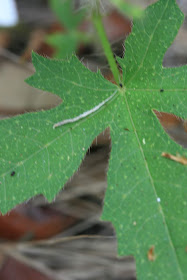There are a great many plants here in Florida that are mistaken for dandelions (Taraxacum officinale) and this is one of them. Carolina desertchickory (Pyrrhopappus caroliniensis) may be a poor substitute name as well as it is neither a "chickory" nor does it occur in the "desert". It is, however, an annual member of the Asteraceae and found throughout the northern two-thirds of Florida in open disturbed sites such as roadways and fields. It also occurs in much of the same types of locations in the eastern half of the US, except the very northernmost line of states.
Carolina desertchickory makes its appearance in the spring as a basal rosette of lanceolate leaves, each about 5 inches long. Some leaves may be deeply lobed, especially near the base, but in others these lobes may be nearly absent. The plants photographed here have leaf margins that are essentially entire.
Flowering occurs in late spring through late summer. The flowers are produced on a flower stalk that stands up to 1 1/2 feet tall. The flower heads are large and showy; measuring slightly more than 1 inch across and composed of many ray petals. The typical color is a bright canary yellow, but lighter shades, such as in the middle photograph, are not uncommon. These flowers are of interest to small bees. Once pollination has occurred, the seed heads mature quickly into "dandelion"-type fluffy seed balls. These are much larger than those found in dandelions and the seeds themselves may measure 1/8 inch in length.
Roger Hammer reports that members of the Cherokee Nation used this plant medicinally as a blood "cleanser" and that its roots have also been eaten as a vegetable. Some caution, however, should be taken in eating wild plants for the first time.
Although I find this native wildflower to be quite attractive, its somewhat weedy nature and the fact that it is an annual make it a poor candidate for the horticulture industry. It is easy to propagate from seed, but it would need to be able to reseed into open soil to persist.










